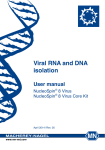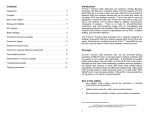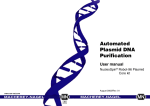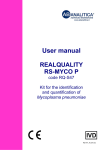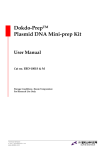Download Manual - Omega Bio-Tek
Transcript
E-Z 96 Blood DNA Kit D1192-00 D1192-01 D1192-02 1 x 96 preps 4 x 96 preps 20 x 96 preps September 2012 E-Z 96 Blood DNA Kit Table of Contents Introduction and Overview.......................................................2 Kit Contents/Storage and Stability.........................................3 Preparing Reagents.......................................................................4 Before Beginning...........................................................................5 E-Z 96 Blood DNA Protocol........................................................6 E-Z 96 Viral DNA Protocol.........................................................10 Troubleshooting Guide.............................................................11 Manual Revision: September 2012 Innovations in nucleic acid isolation 1 Introduction and Overview The E-Z 96® Blood DNA Kit allows rapid and reliable isolation of high-quality genomic DNA or viral DNA from a wide variety of sample sources including fresh, frozen, or anticoagulated whole blood, serum, plasma, bone marrow, body fluids; lymphocytes and cultured cells. This kit incorporates the reversible nucleic acid-binding properties of HiBind® matrix in a high-throughput 96-well format to eliminate proteins, nucleases and other enzyme inhibitors or contaminators from blood or body fluids. Up to 96 samples can be simultaneously processed in a single E-Z 96® DNA plate. The newly designed E-Z 96® DNA plate has a binding capacity of 50 μg DNA per well. Purified DNA is suitable for PCR, restriction digestion, and hybridization techniques. There are no organic extractions, thus reducing plastic waste and hands-on time to allow up to 96 samples to be processed at one time. If using the E-Z 96® Blood DNA Kit for the first time, please read this manual in its entirety to become familiar with the procedures. Blood or other body fluid samples are added to a specially formulated buffer containing detergent and mixed with proteinase. Binding conditions are then adjusted and the sample is applied to the E-Z 96® DNA plate. Two rapid wash steps remove trace contaminants and enzyme inhibitors and pure DNA is eluted in water or low ionic strength buffer. Purified DNA can be directly used in downstream applications without the need for further purification. New in this Edition: This manual has been edited for content and redesigned to enhance user readability. • • • 2 OB Protease is now supplied in a liquid form eliminating the resuspension step to prior to use. OB Protease Solution can also be stored at room temperature for 12 months. Proteinase Storage Buffer is no longer included in the kit. Kit Contents Product D1192-00 D1192-01 D1192-02 1 x 96 4 x 96 20 x 96 E-Z 96 DNA Plate 1 4 20 96-well Square-well Plate (2.2 mL)* 1 2 4 96-well Round-well Plate (1.2 mL) 1 4 20 Caps for Round-well Plate 24 x 8 96 x 8 480 x 8 96-well Racked Microtubes 1 4 20 Caps for Racked Microtubes 12 x 8 48 x 8 240 x 8 BL Buffer 30 mL 100 mL 500 mL Equilibration Buffer 15 mL 45 mL 250 mL OB Protease Solution 3 mL 12 mL 55 mL HB Buffer 45 mL 170 mL 820 mL DNA Wash Buffer 40 mL 125 mL 3 x 200mL Elution Buffer 40 mL 160 mL 2 x 250 mL AeraSeal Film 5 20 100 User Manual P P P Purifications Note: *96-well Square-well Plates (2.2 mL) can be used to collect filtrate from the E-Z 96 DNA Plate. They are designed for repeated use. Wash the plates thoroughly in tap water after each use. Let sit in 0.5M HCl at room temperature for 5 minutes. Rinse with distilled water. Used plates can also be autoclaved after washing. Storage and Stability All components of the E-Z 96 Blood DNA Kit are sguaranteed for at least 12 months from the date of purchase when stored as follows. OB Protease Solution can be stored at room temperature for 12 months. For long-term storage (>12 months), store at 2-8°C. Store all other components at room temperature (22-25°C). Check buffers for precipitates before use. Redissolve any precipitates by warming to 37˚C. 3 Preparing Reagents Dilute DNA Wash Buffer with 100% ethanol as follows and store at room temperature. 4 Kit 100% Ethanol to be Added D1192-00 160 mL D1192-01 500 mL D1192-02 800 mL per bottle Before Beginning Yield and Quality of DNA Determine the absorbance of an appropriate dilution (20 to 50 fold) of the sample at 260 nm and then at 280 nm. The DNA concentration is calculated as follows: DNA concentration = Absorbance 260 × 50 × (Dilution Factor) µg/ml A ratio greater than 1.8 indicates greater than 90% nucleic acid. Alternatively, quantity (as well as quality) can sometimes best be determined by agarose gel/ethidium bromide electrophoresis by comparison to DNA samples of known concentrations. Typically, the majority of the DNA eluted is in monomeric supercoil form, though concatamers may also be present. Storage of Blood Samples Storage of blood samples without previous treatment leads to reduced yields of genomic DNA. For the best result, blood samples should be proceeded as following. • • • For short-term storage (up to a week), collect blood in tubes containing EDTA as anticoagulant, and store at 4°C. For long-term storage, collect blood in tubes containing an anticoagulant and store at -70°C. Thawed frozen blood sample at 37°C with gently agitation before use. Sample Volumes Adjust the volume of each sample to 250 μL. For samples smaller than 250 μL, add the appropriate volume of PBS to bring the volume to 250 μL. For samples larger than 250 μL, split each sample into two 250 μL aliquots and use two wells of the 96-well Round-well Plate (1.2 mL) for lysis. The lysates can be recombined when transferring the samples to the E-Z 96 DNA Plate. 5 E-Z 96 Blood DNA Kit Protocol E-Z 96 Blood DNA Kit Protocol Materials and Equipment to be Supplied by User: • • • • • • Centrifuge capable of at least 3,000 x g equipped with swing bucket rotor Rotor adapter for 96-well plates Water bath, heat block, or incubator capable of 65°C 100% ethanol Multichannel pipet and nuclease-free tips Optional: RNase A stock solution (20 mg/mL) Before Starting: • • • Set water bath, heat block, or incubator to 65°C Prepare DNA Wash Buffer according to the directions in the “Preparing Reagents” section on Page 6 Heat Elution Buffer to 65°C 1. Add 25 μL OB Protease Solution into the bottom of each well of the 96-well Roundwell Plate (1.2 mL). 2. Add sample to each well of the 96-well Round-well Plate. Note: Use 250 μL whole blood, serum, or body fluid for each well of the 96-well Round-well Plate. Up to 6 x 106 lymphocytes or cultured cells in PBS can be used in each well. For sample volumes smaller or larger than 250 μL, adjust the sample volume to 250 μL. See the Before Beginning section on Page 4 for details. 3. Add 250 μL BL Buffer to each sample. Take care not to touch the rims of the wells with the pipet tips which may lead to cross-contamination. Optional: RNA will be co-purified with DNA using this kit. While it will not interfere with PCR, the RNA may be removed at this point. 1. Add 5 μL RNase A (20 mg/mL). 2. Let sit at room temperature for 2 minutes. 3. Proceed to Step 4 below. 6 E-Z 96 Blood DNA Kit Protocol 4. Seal the 96-well Round-well Plate with the Caps for Round-well Plate. Vortex or vigorously shake the plate side to side for 30 seconds to mix thoroughly. Note: Shake the rack side to side, not up and down, to prevent possible leakage around the caps. 5. Briefly centrifuge at 2,000 x g to collect any solution from the caps. 6. Incubate at 65°C for 10 minutes. Rotate the plate gently once during incubation to mix. Note: Incubation at 65°C for more than 30 minutes can cause DNA degradation. 7. Briefly centrifuge at 2,000 x g to collect any solution from the caps. 8. Remove and discard the Caps for Round-well Plate. 9. Add 250 μL 100% ethanol to each well. 10. Seal the 96-well Round-well Plate with new Caps for Round-well Plate. Vortex or vigorously shake the plate side to side for 1 minute to mix thoroughly. 11. Briefly centrifuge at 2,000 x g to collect any solution from the caps. 12. Place the E-Z 96 DNA plate on top of a 96-well Square-well Plate (2.2 mL). Optional: Add 100 μL Equilibration Buffer to each well. Let sit at room temperature for 4 minutes. Centrifuge at 3,000 x g for 5 minutes. Discard the filtrate and reuse the 96-well Square-well Plate. Continue to Step 13. 13. Transfer the samples from Step 11 to each well of the E-Z 96 DNA Plate. 14. Seal the E-Z 96 DNA Plate with AeraSeal Film. 7 E-Z 96 Blood DNA Kit Protocol 15. Centrifuge at maximum speed (≥3,000 x g) for 5-10 minutes. Make sure the samples have passed through the membrane. 16. Discard the filtrate and reuse the 96-well Square-well Plate. 17. Remove and discard the AeraSeal Film. 18. Add 400 μL HB Buffer to each well. 19. Seal the plate with new AeraSeal Film. 20. Centrifuge at maximum speed for 5 minutes. 21. Discard the filtrate and reuse the 96-well Square-well Plate. 22. Remove and discard the AeraSeal Film. 23. Add 700 μL DNA Wash Buffer to each well. Note: DNA Wash Buffer must be diluted with ethanol before use. Please see Page 6 for instructions. 24. Seal the plate with new AeraSeal Film. 25. Centrifuge at maximum speed for 5 minutes. 26. Discard the filtrate and reuse the 96-well Square-well Plate. 27. Repeat Steps 22-26 for a second DNA Wash Buffer wash step. 8 E-Z 96 Blood DNA Kit Protocol 28. Centrifuge the empty E-Z 96 DNA Plate at maximum speed for 10 minutes to dry the plate. Note: This step is critical for removal of trace ethanol that may interfere with downstream applications. 29. Remove and discard the AeraSeal Film. 30. Incubate the E-Z 96 DNA Plate at 65°C for 7 minutes to dry the plate. Note: These drying steps are critical for removal of trace amounts of ethanol that might otherwise interfere with downstream applications. 31. Place the E-Z 96 DNA Plate on the 96-well Racked Microtubes. 32. Add 200 μL Elution Buffer heated at 65°C to each well of the E-Z 96 DNA plate. 33. Let sit at room temperature for 2-4 minutes or in an incubator set to 65°C for 1-2 minutes. 34. Seal the E-Z 96 DNA plate with new AeraSeal Film. 35. Centrifuge at maximum speed for 5 minutes. Note: First elution typically yields 60%-70% of the DNA bound to the plate matrix. A second elution with 200 μL Elution Buffer can increase the yield by 20%. However, increasing elution volume reduces the concentration of the final product. To obtain DNA at higher concentrations, elution can be carried out using 100 μL Elution Buffer. Volumes lower than 50 μL greatly reduce yields. 36. Store DNA at -20°C. 9 E-Z 96 Blood DNA Kit Protocol E-Z 96 Blood DNA Kit Protocol - Viral DNA • Integrated viral DNA or proviral DNA can be isolated by using the same standard protocol as for genomic DNA • Viral DNA or RNA from extracellular viruses can be isolated with the E-Z 96 Viral RNA Kit. To avoid genomic DNA contamination, acellular samples are recommended. Use 10-12 μg carrier DNA (such as poly dA or Poly dT) for each 250 μL sample. Adjust the binding conditions by adding 280 μL 100% ethanol instead of 250 μL at Step 9 of the standard protocol above. 10 Troubleshooting Guide Please use this guide to troubleshoot any problems that may arise. For further assistance, please contact the technical support staff, toll free, at 1-800-832-8896. Problem Cause Solution Incomplete lysis Add the correct volume of BL Buffer and incubate for specified time at 65°C. It may be necessary to extend incubation time by 10 minutes. Sample too large If using more than 250 μL blood, increase volumes of Protease, BL Buffer, and ethanol. Pass lysate through one well successively. Sample too viscous Divide sample into multiple wells, adjust volume to 250 μL with PBS. Cause Solution Poor elution Repeat elution or increase elution volume. Incubation at 70°C for 5 minutes with Elution Buffer may increase yields. Make sure the pH of the water is more than 7.5. Improper washing DNA Wash Buffer must be diluted with 100% ethanol as specified on Page 4. Cause Solution Clogged well Problem Low DNA yield Problem Resin from the plate may be present in eluate. Avoid centrifugation at speeds higher Extended centrifugation than specified. The material can be removed during elution step from the eluate by centrifugation; it will not interfere with PCR or restriction digests. Low A260/ A280 ratio Poor lysis from improper mixing with BL Buffer Make sure to completely vortex the sample with BL Buffer immediately. Incomplete cell lysis n due to insufficient incubation. Increase incubation time with BL Buffer and OB Protease Solution. Samples are rich in protein After applying to wells, wash with 300 μL of a 1:1 mixture of BL Buffer and ethanol and then with DNA Wash Buffer. Silica fine interference Remove the silica fines by centrifugation and check the OD again. 11 Troubleshooting Guide Problem Cause Endonuclease Smeared DNA Contamination from gel Silica fines interference Problem No DNA eluted Problem Ensure to wash the plate with HB Buffer. Remove the silica fines by centrifugation and run the gel again. Cause Solution Poor lysis for improper mixing with BL Buffer Mix thoroughly with BL Buffer prior to loading to the DNA plate. 100% ethanol not added to sample Before applying sample to column, ethanol must be added as prescribed in protocol No ethanol added to DNA Wash Buffer Dilute Wash Buffer with the indicated volume of 100% ethanol before use. Cause Solution Incomplete lysis due to Washing improper mixing with leaves colored BL Buffer residue in Ethanol not added to column DNA Wash Buffer 12 Solution BL Buffer is viscous and the sample must be vortexed thoroughly. Dilute Wash Buffer with the indicated volume of 100% ethanol before use.
























